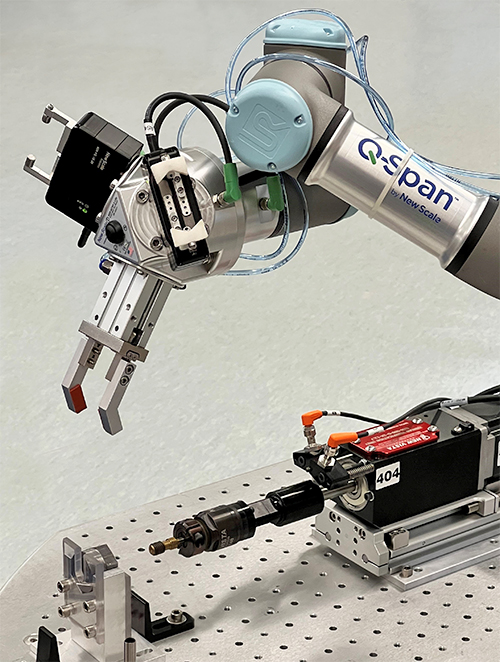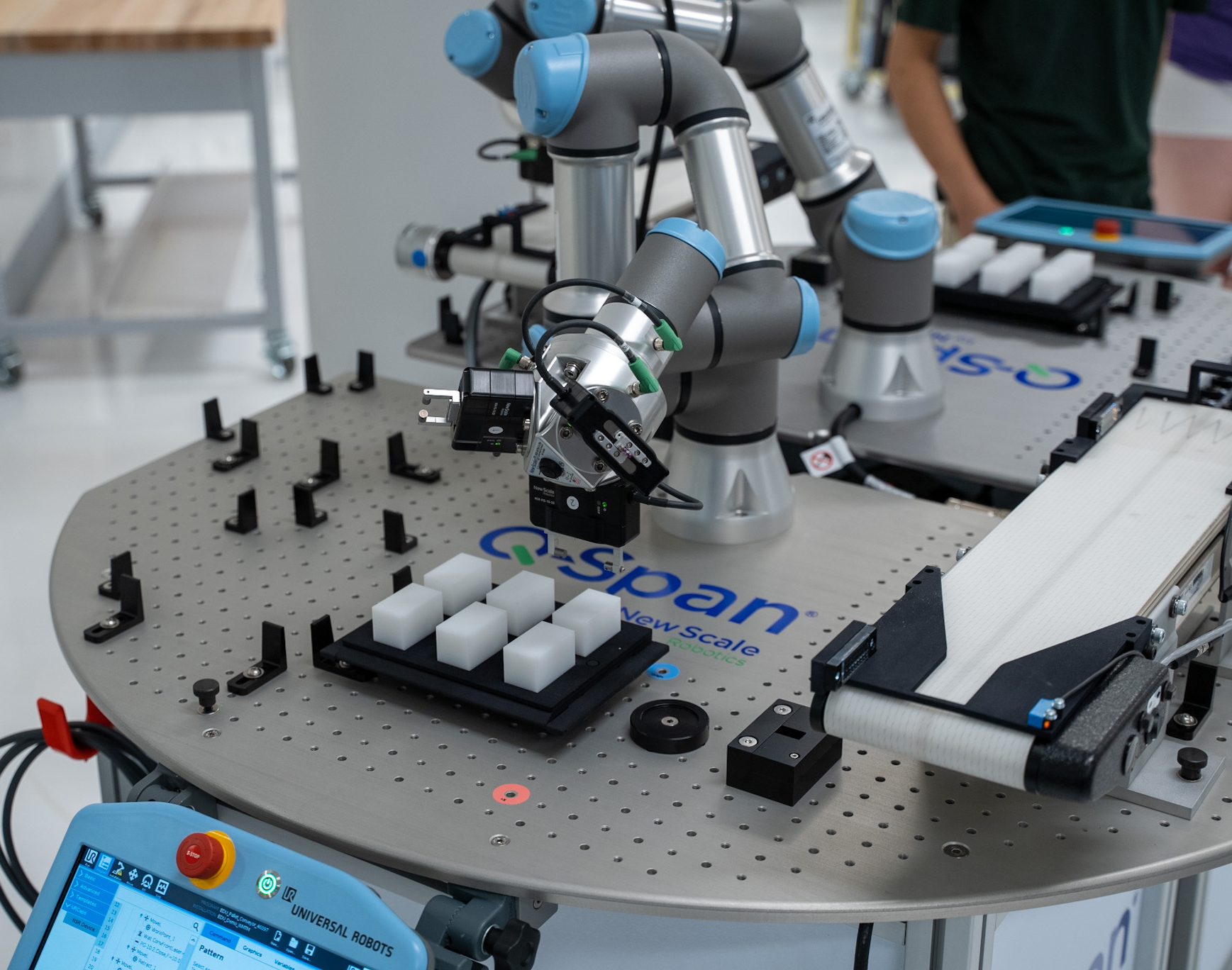1. Can Q-Span measure machined parts?
Yes! Measuring machined parts is a very typical application. As parts are machined, you need to frequently inspect them to ensure that parts are not falling out of spec due to machine tool wear. You can even send your measurements directly to your CNC machine to automatically set machine tool offsets and compensate for this tool wear.
2. Is Q-Span suitable for electronic components?
Some dimensional checks can be required for electronic components, typically housings and other accessory components. Many PCB inspections are completed by using comparative imaging systems to verify that boards are correctly populated, which is not a typical process for the Q-Span system.
3. Can I use Q-Span for plastic molded parts?
Yes! Although the first article, in-process sampling, and final inspections are sometimes perceived as too infrequent to automate, these critical QC checks are often quite time consuming, taking much longer than you may expect! Inspectors will typically run from mold to mold, inspecting parts from each cavity to ensure the process is running smoothly. You can easily automate this process, and even track data by mold cavity, to improve your process control and eliminate the need for inspectors to measure repeat, high running parts.
4. Can I use Q-Span for medical devices?
Yes! Industries with highly regulated and tightly controlled manufacturing processes are great candidates for automation, particularly inspection. These industries can require 100% part inspection, which adds proportionally more labor cost to each manufactured part. Digitizing and automatically collecting data can not only improve your process, but help you avoid a non-conforming inspection rating due to data that is erroneously captured or lost by an inspector.
5. What are the benefits of using a Q-Span Gauging System?
A Q-Span gauging systems are a great way to:
- Lower cost per manufactured item and lower total QC costs
- Make your operations more flexible and scalable
- Improve yields, while reducing scrap
- Drive continuous process improvements
- Improve process quality and reduce defects. Isolate difficult to diagnose causes of process variation and defects.
- Reduce maintenance cost and downtime
- Benefit your workforce by moving them to more productive and engaging tasks
- Remove operator variability from the inspection process
- Improve gauge repeatability and reproducibility (GR&R)
- Increase QC data collection
- Improve operational effectiveness and process efficiency
- Increase the QC department’s capacity
6. Can Q-Span handle complex parts?
Complex parts can be tricky! I have found that this to be a great way to frame your thinking: is if a person can handle and measure the parts wearing a mitten, and/or using tweezers, it is likely a good candidate for automation. Complex dimensions can be measured with many tools, like CMM’s, vision systems, laser scanners, and specialty gauging. If a person wearing the mitten or using tweezers can reliably load and unload the gauge, a robot can too.
7. What if my parts have different orientations?
A few different processes can be used to take randomly oriented parts and present them in a consistent orientation. Let’s review a few examples.
- A cone-shaped part is presented from a conveyor to the robotic gauging system. It may arrive at the end of the conveyor in two ways – the small tip at the pick point, or the large base at the pick point. Smart grippers can overcome this process complexity by measuring the picked feature and either moving the part through the process like normal, or flipping the part 180 degrees, right side up, based on the dimension read by the gripper during the part pickup.
- Parts are randomly oriented in a box or a bin. Parts could be loaded into a bowl feeder, where they can be presented to a single pickup point, however these are inflexible and typically dedicated to only one part. Parts could instead be loaded into a vision-guided bin-picking system, allowing the robot to pick parts in any orientation – this technology is continuously improving and can be useful for higher-mix production.
Do not overlook the cost savings of simply using part trays! While it may be a minor inconvenience, a great incremental step to automating can be to defer complex part pickups to a later date. Often times, just 5-minutes of an operator’s time to populate a few trays can save tens of thousands of dollars from the deployed system, and keep the robot busy for hours at a time! We typically recommend this as a starting point due to the cost savings and reduced complexity of using trays with parts oriented consistently.
8. Can Q-Span measure multiple features on a part?
Yes! We typically take your existing measurement techniques and gauges, and automate those processes. For instance, if you are using calipers, we use a robotic caliper; if you use a bore gauge, we will automate that bore gauge; or if you are using a vision system, we will present parts to that vision system.
9. What gauges can be used with Q-Span?
We can automate gauges from most manufacturers. If we can connect to them with the robot, we can likely automate it. Here are several examples:
- Calipers
- Thread gauges
- Height or drop gauges
- LVDT probes
- Bore gauges
- Go/no-go gauges
- Air gauges
- Laser micrometers
- Vision systems
- 2D telecentric profilers
- AND MORE
10. What software does Q-Span use?
New Scale Robotics has made an easy-to-use software app for both Universal Robots and FANUC CRX cobots called “NSR Devices”, which controls our robotic gripper/calipers and communicates with some of our frequently used gauges.
We export measurement data from the robot in a basic ASCII format. Most customers export the data in a basic CSV or Excel format, however we can also export data in a format directly readable by your quality management system or preferred SPC software program.
11. Is Q-Span suitable for repetitive, high-mix production?
We specialize in higher-mix production. Easy to use software apps allow you to deploy the system for a wide variety of parts. Families of parts are a typically recommended starting point, since those like-parts can use similar programs as templates, making redeployment to new parts much easier.
12. Is Q-Span easy to set up and integrate?
We typically deploy our robots at our customer’s facility within the first 1-3 hours after our arrival on-site. Our team spends the rest of the time training your team how to use the system, and program it to be used for other parts within your facility.
13. How much does Q-Span cost?
Typical systems can range from $100k-$300k. This is highly dependent upon the complexity of the process and gauging required.
14. Does NSR offer support for Q-Span?
We offer 2-days of on-site installation and training, a 1-year warranty, remote support, and can even travel back to your facility to provide on-site support. New Scale can also include a remote monitoring support package, upon request, allowing our team to support any robot with live video feed and the ability to view your robot programs remotely, providing an extra level of guidance and support post-installation. Extensive support programs, both on-site and remote, are available for the robots deployed from our partners FANUC and Universal Robots. Contact us for more information.
15. Does NSR offer automated gauging for other robots?
New Scale Robotics currently works with FANUC CRX robots and cobots from Universal Robots.
- New Scale Robotics is a Certified Systems Integrator (CSI) for Universal Robots
- New Scale Robotics is an Authorized Systems Integrator (ASI) for FANUC America Corp.


